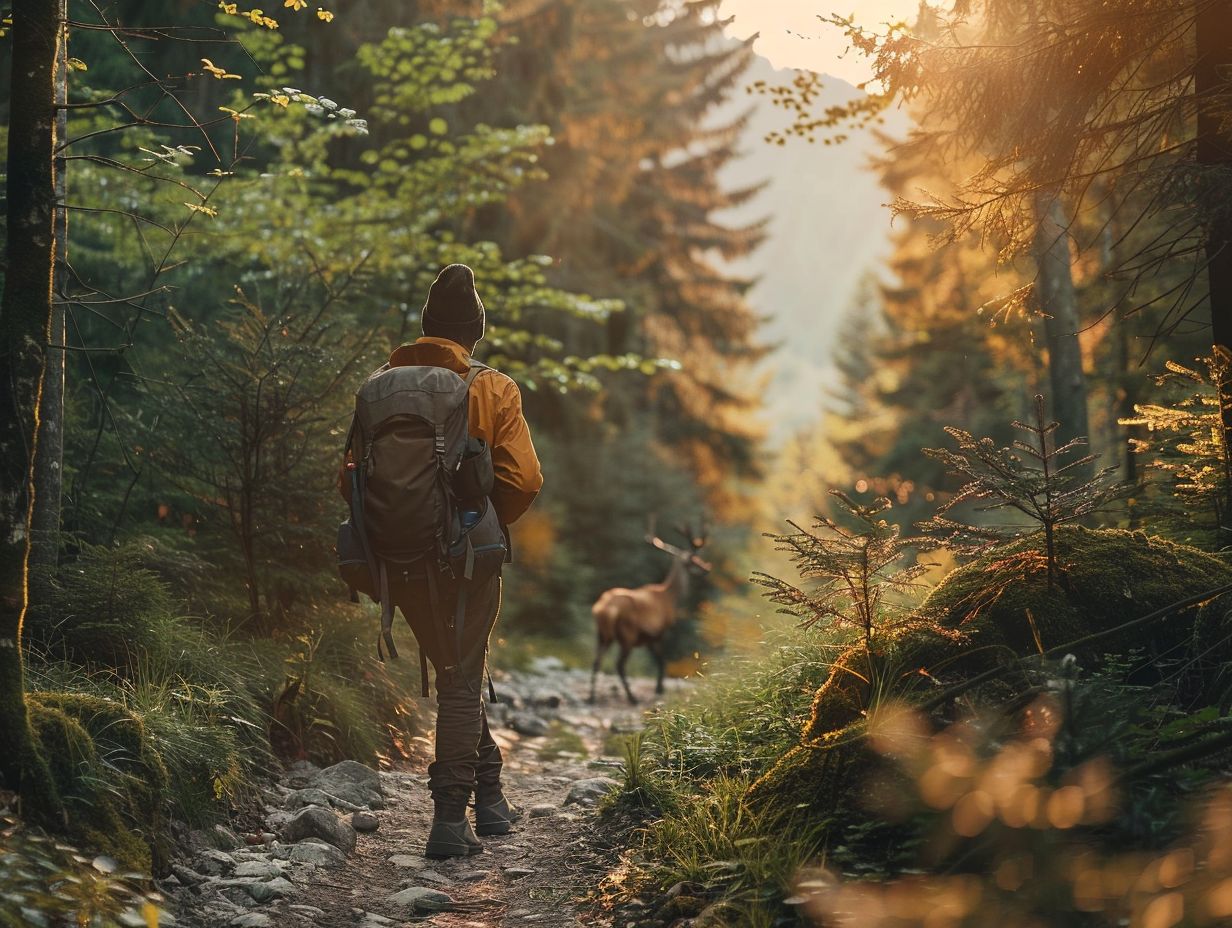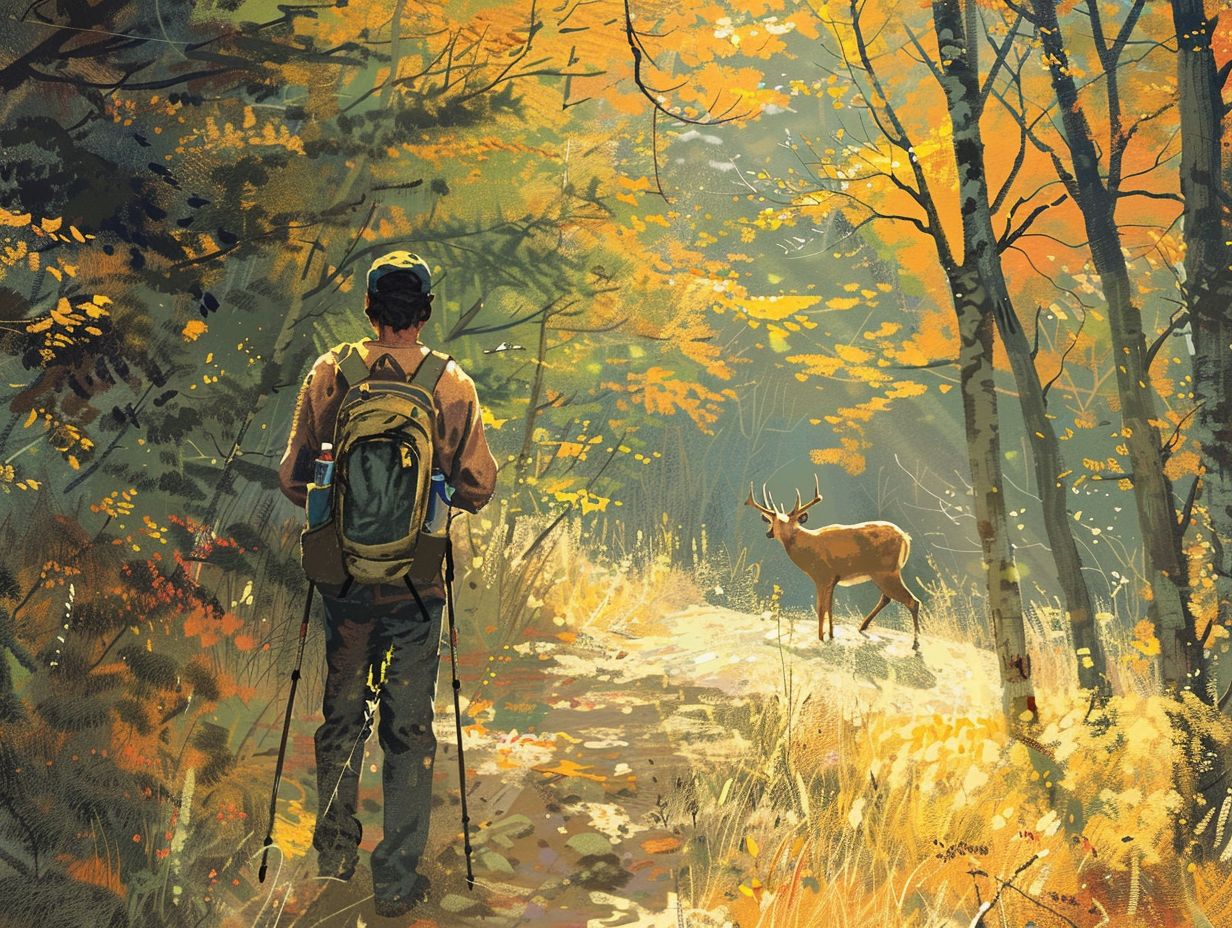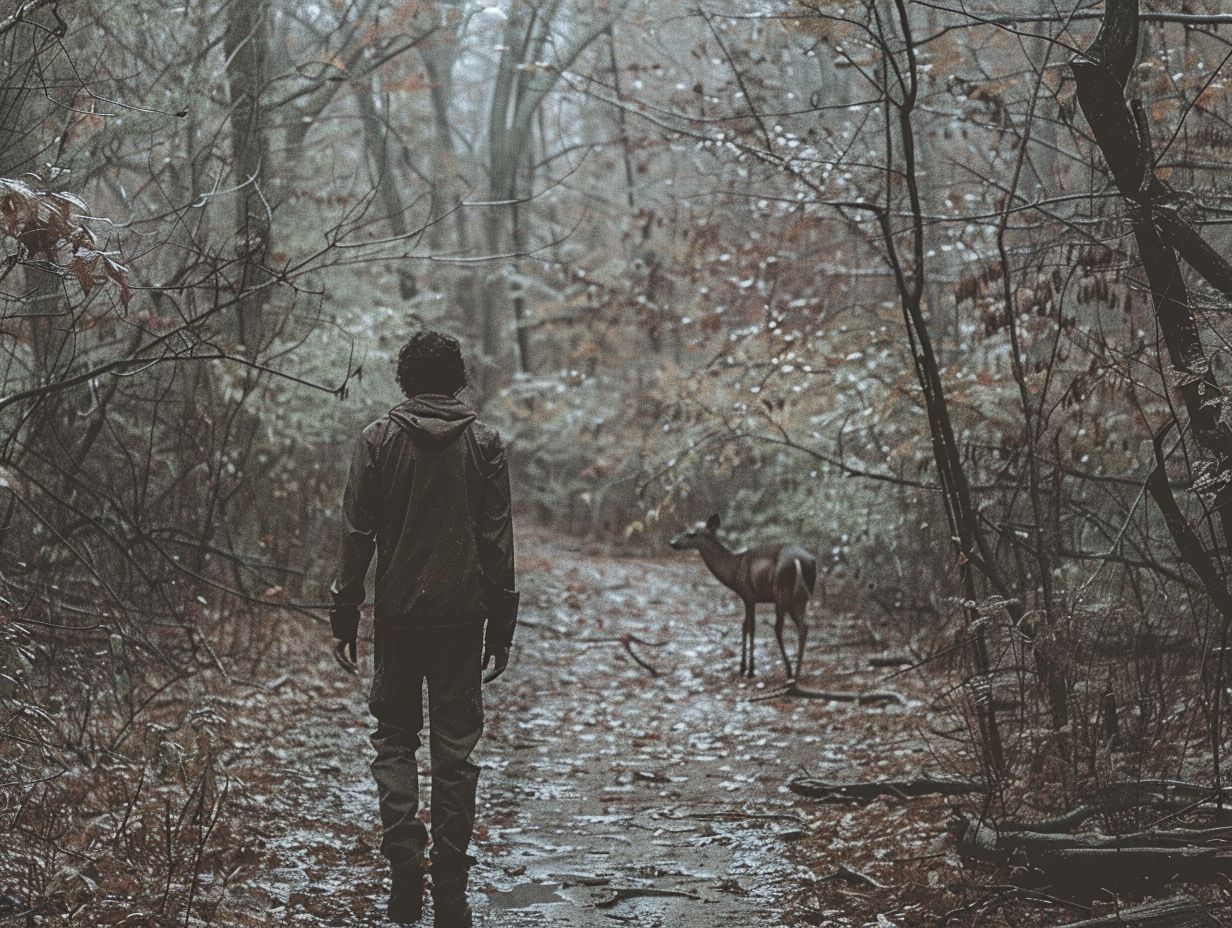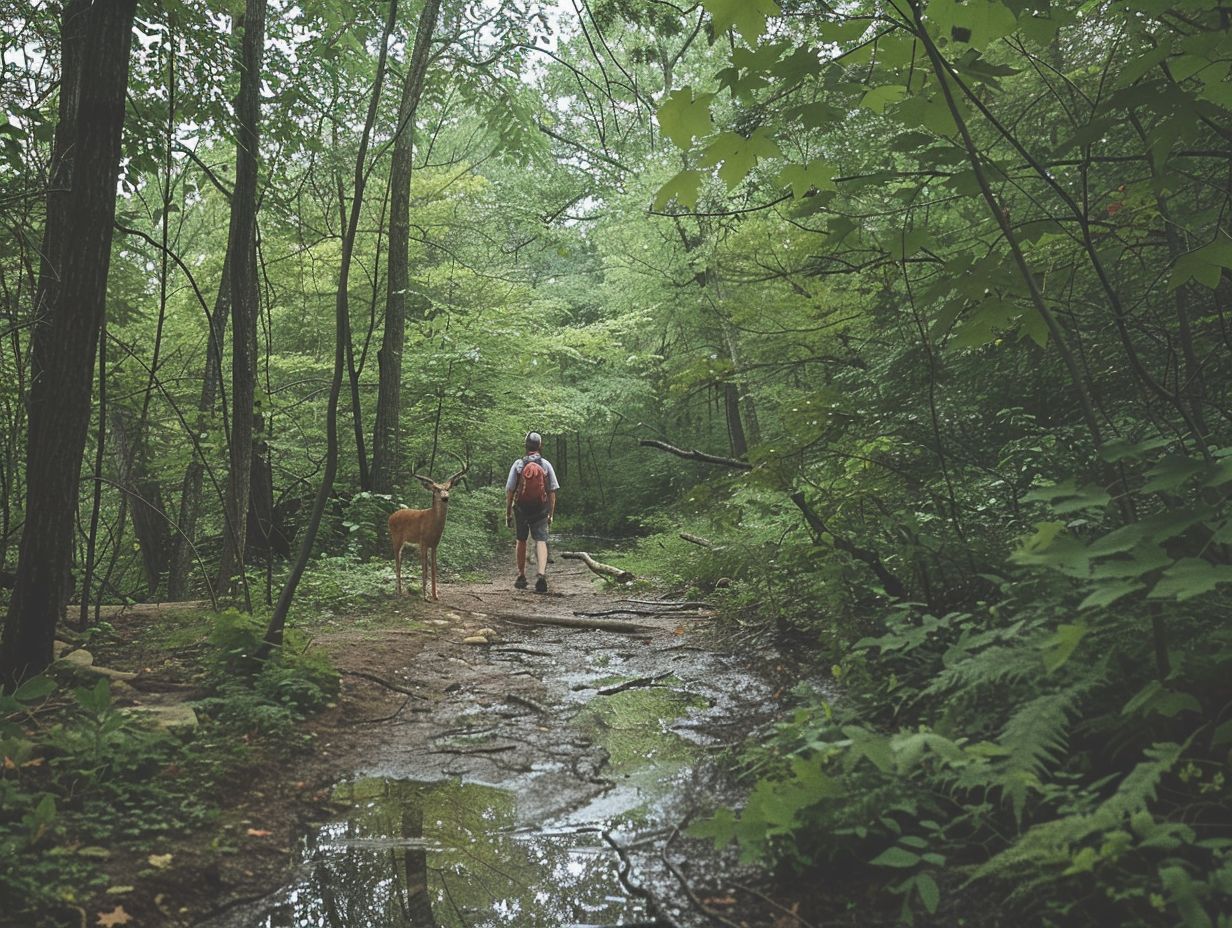Exploring the great outdoors through hiking can be an exhilarating experience, but encountering wildlife along the way can pose certain risks. From common sightings to potentially dangerous encounters, it’s crucial to be prepared and informed before hitting the trails.
This article covers the types of wildlife you may come across while hiking, the precautions you should take before setting out, tips for safely navigating wildlife areas, what to do if you encounter wildlife on the trail, and how to handle emergency situations.
Stay tuned for essential advice on staying safe from wildlife while hiking.
Key Takeaways:

- Research the area and wildlife before hiking to understand potential risks.
- Stay on designated trails, make noise, properly store food, and keep a safe distance from wildlife while hiking.
- In the event of a wildlife encounter, stay calm, make yourself appear larger, and slowly back away. Call for help if necessary.
Understanding the Risks of Wildlife Encounters while Hiking
Traversing through the unspoilt wilderness regions presents a remarkable opportunity to witness wildlife in their natural environments; however, it is accompanied by inherent risks and hazards that hikers must acknowledge to ensure their safety.
What Types of Wildlife are Commonly Encountered while Hiking?
Whilst traversing the various trails, individuals may come across a diverse array of wildlife, including mammals, birds, reptiles, and insects that inhabit the rich and varied ecosystems of North America.
Encounters with wildlife serve to enhance the excitement of any outdoor expedition. In specific regions, it is not uncommon to witness majestic creatures like bears, moose, and mountain goats.
Whether observing a Peregrine falcon gracefully gliding through the sky or hearing the rustling of a snake in the undergrowth, these moments provide insights into the distinctive habitats that these animals inhabit.
The observation of these animals within their natural settings acts as a poignant reminder of the delicate equilibrium of nature and underscores the significance of conservation initiatives aimed at safeguarding these species.
What are the Most Dangerous Wildlife Encounters while Hiking?
Among the most perilous wildlife encounters while hiking are those involving large predators such as black bears, grizzly bears, cougars, and alligators, which can present significant threats to hikers if not managed appropriately.
An understanding of the behaviour exhibited by these animals is essential for hikers to ensure their safety in the wilderness.
Predators like black bears and grizzlies tend to be more defensive and may resort to aggression if they perceive a threat. Cougars are known for their stealth and ambush tactics, while alligators can display aggressiveness, particularly within their territorial boundaries.
Adherence to trail safety protocols, such as generating noise to signal animals of your presence and securely storing food to prevent attracting them, plays a pivotal role in diminishing the likelihood of wildlife attacks during outdoor excursions.
Precautions to Take Before Hiking
Before starting a hiking expedition, it is essential to put in place various precautions to ensure the safety of both yourself and the conservation of the wildlife that may be encountered during the journey.
Research the Area and Wildlife
It is crucial to conduct comprehensive research on the area and its wildlife to ensure a successful and safe hiking experience. This research provides valuable insights into the local wildlife habitats and behaviours, which are essential for hikers to navigate the environment effectively.
Understanding the wildlife that inhabit the hiking area enables hikers to make informed decisions that prioritise their safety and the preservation of the natural surroundings. Wildlife education plays a significant role in fostering a sense of respect towards wildlife habitats, encouraging hikers to minimise their impact and recognise the intricate balance of ecosystems.
Implementing proper wildlife management practices not only benefits the animals but also enriches the overall hiking experience, allowing hikers to observe and engage with wildlife in a responsible manner.
Check the Weather and Trail Conditions

Before setting off on your hike, it is advisable to always check the weather forecast and assess the trail conditions to properly prepare for any unforeseen circumstances that may impact your safety and hiking expedition. By taking the time to evaluate the weather patterns and trail conditions, informed decisions can be made about your outdoor adventure.
Being aware of approaching storms, slippery terrain, or potential risks along the route enables proper planning, thus ensuring a safer and more enjoyable journey. Monitoring these factors not only enhances the overall hiking experience but also reduces the chances of encountering dangerous situations.
It is essential to emphasize that thorough preparation is crucial in guaranteeing a successful and unforgettable outdoor adventure.
Bring Appropriate Gear and Supplies
Ensuring safety and preparedness during a hiking trip is paramount, and it is imperative to bring the appropriate kit and supplies. These provisions are essential for managing unexpected wildlife encounters and other emergencies.
Bear spray serves as a critical tool in deterring aggressive wildlife, particularly in regions where encounters with bears can pose significant risks. Similarly, first aid kits are essential for addressing injuries on the trail, ranging from minor blisters to more severe wounds.
Proper clothing plays a crucial role in safeguarding hikers from the elements. This includes wearing moisture-wicking layers, sturdy hiking boots, and clothing suitable for prevailing weather conditions. By being adequately equipped to handle potential challenges in the wilderness, outdoor enthusiasts can significantly enhance their safety and ensure a more enjoyable hiking experience.
Tips for Safe Hiking in Wildlife Areas
Adhering to practical guidelines for hiking in wildlife areas can significantly reduce the likelihood of dangerous encounters and help maintain a harmonious coexistence with the natural environment.
Stay on Designated Trails
Adhering to designated trails is essential for both personal safety and the conservation of wildlife habitats. This practice serves to minimise human impact on the environment and mitigate the likelihood of becoming disoriented.
These trails are meticulously designed to guide visitors through protected areas while minimising disturbances to the natural ecosystem. Park management allocates resources towards the upkeep of these paths to ensure they remain safe and sustainable for both guests and indigenous wildlife.
By adhering to established routes, visitors can aid in the prevention of erosion, the trampling of fragile vegetation, and the disruption of animal habitats. This conscientious approach not only preserves the aesthetic appeal of the surroundings but also fosters an environment where wildlife can thrive undisturbed in their natural habitats.
Make Noise and Be Aware of Your Surroundings
Creating sound and maintaining situational awareness whilst hiking can serve as a preventive measure against unexpected wildlife encounters by signalling your presence to animals, affording them an opportunity to evade interaction with you.
This proactive strategy not only contributes to personal safety but also demonstrates a respectful attitude towards the natural environment inhabited by wildlife.
A comprehensive understanding of animal behaviour plays a pivotal role in advancing trail safety. For instance, being aware that bears are attracted to specific scents enables hikers to refrain from using strong fragrances during outdoor excursions.
Through a combination of attentiveness and knowledge, individuals taking part in hiking activities can enjoy the splendour of the natural world while minimising potential hazards associated with wildlife encounters.
Properly Store Food and Dispose of Trash
Properly storing food and disposing of rubbish during hiking expeditions are essential practices for wildlife safety, as they contribute to the prevention of animals being attracted to human scents and developing a dependency on human food sources.
When preparing for outdoor activities, it is imperative to ensure that all food items are securely sealed in airtight containers and stored out of the reach of animals.
Waste should be carried in designated bags and appropriately disposed of in designated bins or facilities. In areas where encounters with wildlife are common, especially in regions inhabited by bears, adherence to these protocols becomes increasingly crucial.
Respecting and following trail etiquette, such as staying on designated paths, is crucial for minimising disruptions to animal habitats. Local animal control services play a significant role in overseeing interactions with wildlife and upholding the safety of both humans and animals.
Keep a Safe Distance from Wildlife

It is crucial to maintain a safe distance from wildlife during hikes to ensure your safety and the welfare of the animals. This practice helps to prevent stress and potential attacks, safeguarding both parties involved.
Guidelines recommend maintaining a distance of at least 100 yards from large mammals like bears and moose in their natural habitat. For smaller animals such as birds and squirrels, it is advisable to keep a distance of approximately 30 feet.
Approaching wildlife too closely can disrupt their natural behaviours and lead to unnecessary stress. By adhering to these guidelines, individuals not only protect themselves but also demonstrate respect for wildlife and contribute to conservation efforts.
What to Do if You Encounter Wildlife on the Trail?
Encountering wildlife on the trail can be an exhilarating yet potentially hazardous experience. Understanding how to respond appropriately is essential to ensuring both personal safety and the welfare of the animal.
Stay Calm and Do Not Run
Maintaining composure and refraining from sudden movements in the presence of wildlife are essential measures to prevent triggering the animal’s predatory instincts and escalating the encounter.
When confronted with wildlife, abrupt actions or attempts to flee may be misconstrued as acts of aggression or prey-like behaviour, potentially inciting a defensive response from the animal.
By displaying a calm demeanour and moving slowly, individuals are less likely to be perceived as a threat, thereby diminishing the animal’s sense of intimidation. This non-confrontational approach contributes to diffusing the situation and decreasing the likelihood of a hazardous interaction.
It is important to bear in mind that animals typically seek to avoid conflict and often respond to human cues such as body language and vocal tone.
Make Yourself Appear Larger
When encountering wildlife in their natural habitat, it is essential to understand animal behaviour and respond appropriately to ensure safety. One effective technique is to make oneself appear larger by raising the arms and standing tall. This behaviour signals dominance and can help deter animals from approaching, reducing the likelihood of an attack.
By adopting this posture, individuals mimic a potential threat, causing many animals to reconsider engaging.
This strategy is particularly effective with species that rely on intimidation tactics or prefer to avoid conflicts. Heightened awareness of wildlife enables individuals to anticipate animal reactions and modify their behaviour accordingly, fostering safer interactions for both humans and animals.
Slowly Back Away and Give the Animal Space
Gently and gradually moving away, whilst allowing the animal space, can assist in de-escalating a potentially hazardous situation by enabling the animal to perceive reduced threat and withdraw independently.
When approaching the animal, it is imperative to take measured, unhurried steps whilst refraining from making direct eye contact, as this behaviour communicates to the animal that you do not pose a threat.
It is crucial to exhibit a composed demeanour and refrain from sudden movements that may startle the animal. Abruptly turning your back on the animal should be avoided, as it can be interpreted as a challenge.
When the situation intensifies and the animal displays signs of aggression, it is advisable to withdraw slowly and enlist the assistance of wildlife removal experts who are equipped with the necessary skills to manage hazardous wildlife encounters safely.
Emergency Situations: When to Call for Help
In cases of emergency situations arising during a hiking expedition, such as facing an aggressive animal or experiencing a wildlife attack, possessing the knowledge of when and how to summon assistance is imperative to guaranteeing a prompt and efficient response.
When to Use Bear Spray or Other Deterrents

Bear spray and other deterrents are vital tools that can save lives during wildlife encounters, particularly in areas inhabited by bears. It is imperative to understand when and how to utilise these tools for your safety.
When engaging in activities such as hiking or camping in bear-populated regions, it is essential to have bear spray easily accessible and prepared for immediate use. If confronted by a bear, it is crucial to maintain composure, speak calmly, and gradually retreat while readying the bear spray.
Direct the spray towards the bear, aiming for its face, and discharge a brief burst to establish a barrier between yourself and the animal. Deterrents should only be utilised in self-defense or as a final recourse when all other methods have failed.
It is important to note that wildlife authorities are adequately equipped to manage such encounters, and thus any incidents should be promptly reported to them for assistance.
How to Handle Injuries or Attacks from Wildlife
If there is sustaining an injury or encountering a wildlife attack, possessing the knowledge of administering first aid and promptly seeking emergency assistance can prove pivotal in determining the outcome of the situation.
- Following a wildlife attack, the initial step is to prioritise personal safety and distance oneself from the animal, relocating to a secure environment.
- Promptly evaluate the circumstances to gauge the severity of the injuries sustained.
- Apply pressure to any bleeding wounds utilising a sterile cloth or bandage to mitigate further bleeding.
- Maintaining composure and focus is imperative during such an emergency.
- Following addressing immediate hazards, it is imperative to expeditiously seek emergency aid to secure appropriate medical care and avert potential complications.
Frequently Asked Questions
What precautions should I take to stay safe from wildlife while hiking?
It is important to research the specific area where you will be hiking and be aware of the potential wildlife you may encounter. Bring appropriate safety gear, including bear spray, and never approach or feed any animals.
How should I behave if I encounter a wild animal while hiking?
Remain calm and avoid making sudden movements. Slowly back away and give the animal space to avoid feeling threatened. Do not run or make loud noises.
What should I do if I come across a bear while hiking?
If you see a bear in the distance, make your presence known by speaking calmly and waving your arms. If the bear approaches, stand your ground and remain calm. Use bear spray if necessary, and slowly back away while facing the bear.
What should I do if I encounter a snake while hiking?
Most snakes are non-venomous and will not attack unless provoked. If you do encounter a snake, slowly back away and give it space to retreat. If you are bitten, seek medical attention immediately.
How can I protect myself from insect bites while hiking?
Wear insect repellent, long pants, and closed-toe shoes while hiking. Stay on marked trails and avoid tall grass and bushes where insects may hide. Check for ticks after your hike and remove any promptly.
What should I do if I get lost while hiking in an area with wildlife?
If possible, stay in one place and wait for help. Make noise periodically to alert others of your location. If you must keep moving, follow a stream or river to civilization, and be aware of your surroundings for potential wildlife encounters.

